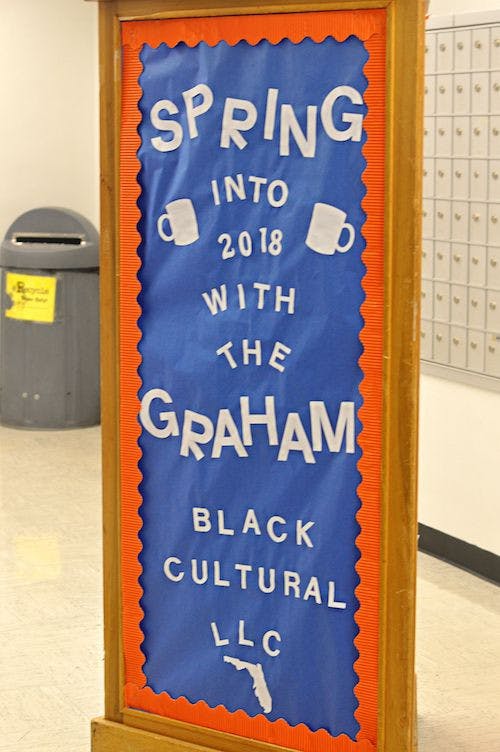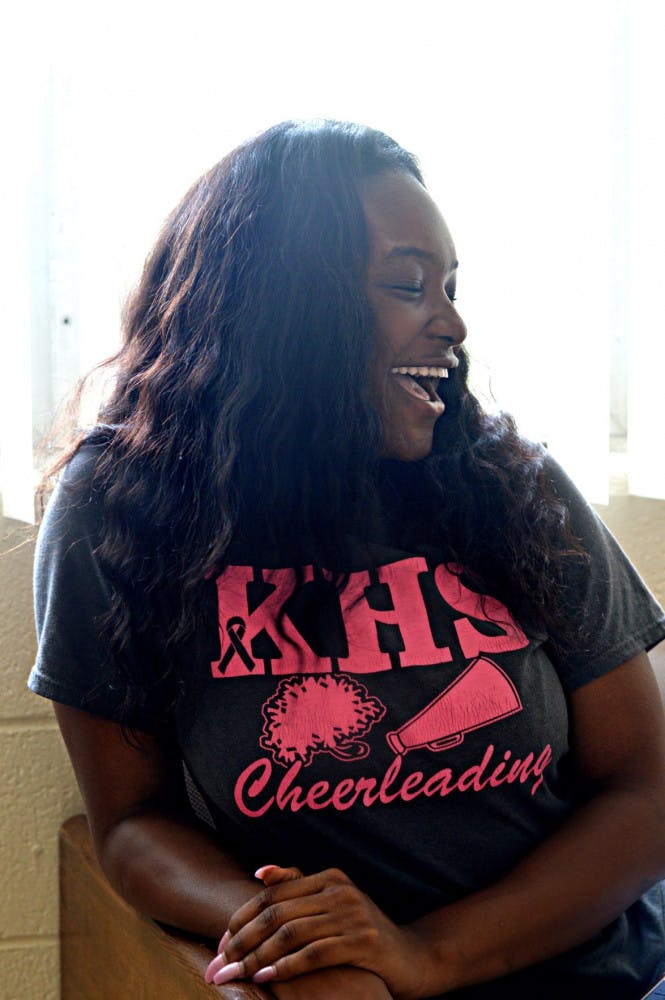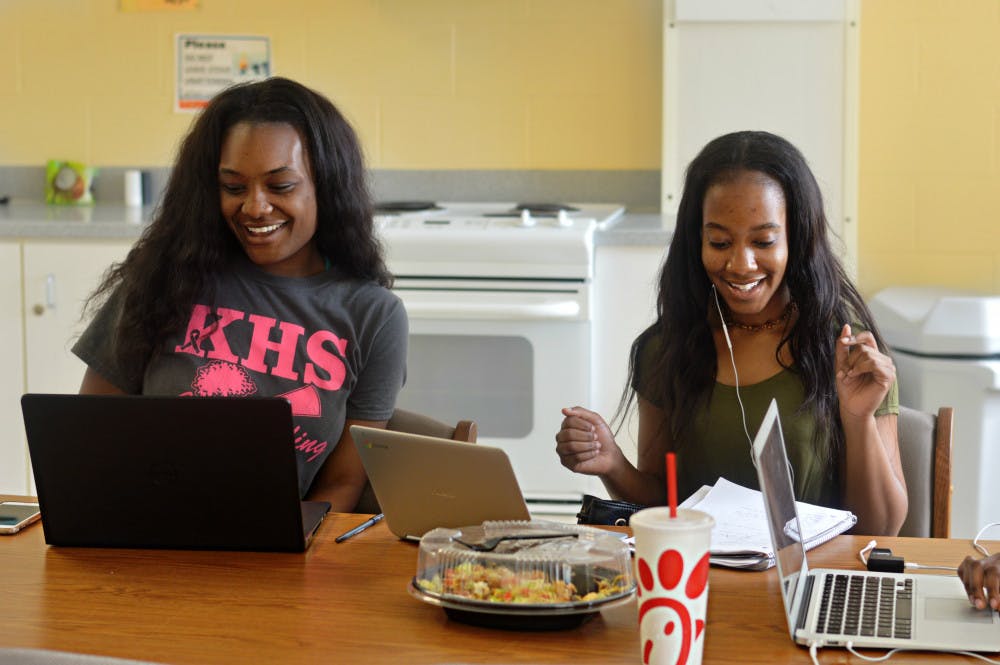After a 2015 The Washington Post article reported the plunging numbers of UF’s black students, the former vice president for Student Affairs commissioned the Black Student Affairs Taskforce — a group of staff, faculty and students — to research how to improve the campus experience for black students.
A residential space for black students was one of the key suggestions.
In Fall 2017, UF opened the Black Cultural Living Learning Community in Graham Hall.
In its inaugural year, 52 of Graham Hall’s 203 residents are in the Living Learning Community. About half of Graham residents are in AIM, an academic support program with a majority black population. Although many AIM students didn’t sign up to be in the Living Learning Community, they live alongside it.
One year into the program, The Alligator asked students about their experiences. Most residents said they’re excited to have a space dedicated to their culture. However, some said more can be done to promote the community.
• • •
Growing up, Vanessa Nevy said she never felt like a minority.
Surrounded by other black and Hispanic residents in Kissimmee, she felt at home in the neighborhood she lovingly nicknamed “Little Puerto Rico.”
But when she walked into a lecture hall during her first Fall semester at UF, she felt isolated.
Nevy was the only black student there.
The 18-year-old UF advertising freshman noticed every time she was the only black person in the room — which was often. She was one of two black female students in her Fall criminology class when a white student argued against the Black Lives Matter movement. Nevy said she couldn’t speak up.
“I got too frustrated,” she said. “I couldn’t put my words together or else I would sound too passionate or I would come across as the angry black girl.”
But she found a space free from judgement in Graham Hall at the Black Cultural Living Learning Community.
One night around Winter Break, Nevy and two of her friends talked in the hall’s lobby. Soon the group of three grew to 10 friends laughing and debating rap music, sparked by one of the residents saying “Young Thug is the best rapper out.”
Half the crowd jeered, saying it wasn’t true, while the others argued in Young Thug’s defense.
Nevy said they agreed to disagree — but she still thinks Kendrick Lamar is the best.
“I don’t think that would happen anywhere else,” Nevy said. “In Graham, people actually stop and talk to you.”

UF opened the Black Cultural Living Learning Community in Fall 2017. A bulletin board pictured greets students in the Graham Hall lobby.
UF has 17 Living Learning Communities, which are residence halls that bring together students with similar interests. The Black Cultural Living Learning Community holds occasional events, family dinners and decorates bulletins to promote black culture and history.
By November, Nevy thought of the residence hall as home.
As she ate a family dinner of bolognese pasta, breadsticks and salad with a dozen of her peers, her resident assistants and graduate hall director talked about building a family. Still, Nevy’s favorite memories are the spontaneous laughs over black Twitter memes with friends in the hall.
Nevy is one of the 13 community residents who is also in the AIM program. But other AIM students who live in the area didn’t opt-in to the community.
AIM requires its students to live together during Summer B, but many stay in the same residence hall in Fall and Spring. This year, the program placed 159 students in the Graham Area. Ninety-two AIM students were placed in Graham Hall, the same building that houses the Black Cultural Living Learning Community, said Mary Jordan, Housing and Residence Education assistant director.
Although the black cultural community only consists of the 52 residents who registered for it, any student who lives in the hall can participate in events, she said.

Chenetrice Simpson, 19, laughs while sitting in Graham Hall. Simpson did not sign up for the Black Cultural Living Learning Community, but has become close with her roommate, Orchid Thomas, who did sign up for the community.
Chenetrice Simpson, a UF African American studies and criminology and law freshman, said she didn’t want to feel like a test run to see if the community would be successful. Simpson, an AIM student, did not sign up for the black cultural community.
“I don’t wanna feel like I’m some kind of experiment,” the 19-year-old said.
Simpson said her concerns boil down a lack of support from the university.
“I feel like AIM is doing a good job, but UF is just not backing them up,” Simpson said.
Simpson worries that AIM might be underfunded by the university and wishes it was able to provide students with a full-year scholarship. As a first-generation student and the daughter of a single mother, Simpson takes money seriously.
Simpson said that if UF can pay to expand the Career Resource Center in Reitz Union and replace Leonardo’s with a new School of Music, it can afford to renovate Graham Hall, especially if the Black Cultural Living Learning Community is housed there.
“When you give to people like us and tell us one thing that seems promising, we’re really going to hold you to your word,” Simpson said.
Housing and Residence Education suggests residential areas for AIM students depending on the area’s resources and the amount of students, Jordan said. For the previous two academic years, AIM students stayed in the Yulee Area. Next year, they’ll be in the Murphree Area.
Office of Academic Support director Angeleah Browdy said she was concerned AIM students would feel obligated to be a part of the Black Cultural Living Learning Community. She said she thinks Housing Residence and Education considered AIM’s large minority population when it decided where to put students.
“I do think that it wasn’t a coincidence that Housing suggested Graham,” Browdy said.
Orchid Thomas, a UF advertising freshman and Simpson’s roommate, said the hall’s sense of community comes from the relationships students made with each other, mainly through AIM.
Growing up in an Afro-Caribbean household, Thomas didn’t always feel connected to African American culture. The 20-year-old signed up for the Black Cultural Living Learning Community to bridge that gap.
She said she expected a space where people can celebrate black culture, but the community wasn’t effective.
The Black Cultural Living Learning Community was a step in the right direction, but upholding diversity takes more effort than labelling a residential space as “black,” Thomas said. She said the community and its events, like seminars on natural hair in the workplace, are promoted to residents, but black culture itself should be showcased to the rest of the university. Still, she said she has faith in the community.
“It don’t seem like it’s a part of UF, almost,” Thomas said. “It’s like some little project in the background.”
Jada Cameron, a 19-year-old UF architecture freshman and Nevy’s roommate, didn’t realize she lived in the Black Cultural Living Learning Community when she moved into Graham in Fall. Cameron, who is black, knew the community existed but didn’t sign herself up, she said.
When Cameron found out she was living in the community, she was surprised — she thought the community would be more noticeable, especially as the only Living Learning Community dedicated to racial identity.
“We live in a predominately white school, so I thought there’d be more of an effort to expand black culture,” she said.
Mackintosh Joachim, an 18-year-old psychology and women’s studies freshman and Student Government senator, said he initially wasn’t sure where he belonged on campus. After finishing his Summer term as an AIM student, Joachim decided to opt into the community.
Joachim and some of his floormates started an unofficial open-door policy for friends to come and go. After class, they meet in one of their residence hall rooms to catch up and do homework, but they mainly play video games like Injustice and Fortnite.
“We trust each other, and we created this wonderful friendship that I think no one else on campus has,” Joachim said.
When Joachim visited a friend at the Pre-Health Living Learning Community in North Hall, the silence was deafening. Around 6 p.m., the halls were quiet, and students passing each other in the hallway rarely stopped to say hello. The energy is different at Graham, he said. Even Trusler, another residence hall in the Graham Area, is quiet in comparison.
The number of students who decide to room in the community next year is unknown until May, but Joachim hopes more black students take advantage of it — not because they feel forced to, but because they willingly sign up.
Joachim said he finds solace in the Living Learning Community when he feels UF’s promise of diversity and inclusion only goes skin deep.
He said the family he’s gained from the community inspired him to be vocal about black students’ concerns, like whether Graham’s residents would be safe when white nationalist Richard Spencer came to speak at UF in October.
“Here at UF, they have a culture of you matter, we care,” he said. “To be honest, I don’t see it.”
Nevy hesitated before answering whether she feels safe at UF. Although she feels protected as a student, she cannot say the same as an African American. For students of color, safety is relative.
“I always have to have a guard up because I know that there are forces against me, there are stereotypes against me,” she said.
When Spencer came to UF, most of the community’s residents left campus. The few who stayed on Joachim’s floor locked their doors that day.
But Nevy and her roommate, who couldn’t get a ride home, were forced to stay in Graham. After shutting the blinds and turning off the lights, they sat down to study, straining to see under lamp light. They bunkered down like they were waiting for a hurricane. They didn’t even talk to each other.
As Cameron studied for “What Is The Good Life” and Nevy watched the Facebook livestream of protesters, they wondered if white nationalists would come barreling down to the black cultural area.
“We didn’t really want to see what was going on outside. We didn’t want to see if it would come closer to us on campus,” Nevy said.
But there is comfort in people who know her fears and feel them too, she said. Students like Cameron and Nevy want to live somewhere with people in their corner, with people who always have their back.
The community holds a special place in Nevy’s heart. But she doesn’t want UF to simply slap a label on the community and use it for advertising without putting in work. She wants the university to do more than hold the occasional seminar.
She wants UF to add meaning behind the name.
“If someone is willing to put in the work towards it, it can be what we dream of it to be,” she said.
Contact Amanda Rosa at arosa@alligator.org. Follow her on Twitter at @AmandaNicRosa.
Chenetrice Simpson, 19, and Orchid Thomas, 20, talk and study in the second floor lounge of Graham Hall, where the Black Cultural Living Learning Community is located.






